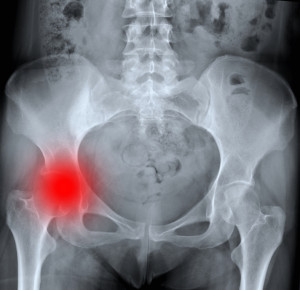
What is Avascular Necrosis?
Avascular Necrosis (AVN) is a disabling and painful condition that can affect many bones in your body, most commonly in the hip and knee joints. Also known as osteonecrosis or “bone rot”, it is caused by a loss of blood supply and subsequent injury to the bone. Certain anatomical areas are more susceptible to this process due to their already tenuous blood supply. For example, the reason that AVN is so common in the hip is that the head of the femur gets its blood supply in a retrograde fashion; that is, the blood flow has to make a u-turn from its path down the leg and travel upwards to reach its destination.
Once the blood flow is compromised, bone cells begin to die and start to lose structural integrity. This process is very painful and often makes walking difficult. As the disease progresses, the round, smooth joint surface begins to collapse and lose its smooth contour. The affected joint then becomes stiff and the cartilage begins to wear away causing arthritis.
What are the Causes of AVN?
Avascular necrosis can be caused by conditions that cause your blood to become thick and sticky or conditions that damage your arteries. When this happens your blood has more difficulty traveling through small arteries. Diseases that increase the risk of AVN include sickle cell disease, rheumatoid arthritis, and other autoimmune diseases. Steroid use and alcohol intake are also associated with avascular necrosis, especially large quantities over a long time period. Scuba divers can also get AVN when they surface too quickly and small nitrogen bubbles obstruct blood flow.
Treatments for AVN by our NJ Orthopedic Surgeons
Avascular necrosis can be treated successfully in many cases if it is diagnosed early. The goals of treatment are to allow healing of the damaged (necrotic) bone and prevent collapse of the joint surface. Certain medications have been shown to strengthen and stabilize the bone, which can reduce pain and slow down the process of AVN. Surgical treatments can improve blood supply to the necrotic area and provide structural support while allowing the bone to heal. Core decompression is a surgical procedure that involves drilling the necrotic bone.
A new procedure using the Zimmer Osteonecrosis Intervention Implant has shown improved success. This technique uses trabecular metal, which is inserted into the necrotic area. The trabecular metal implant provides structural support, preventing collapse, and its unique micro-architecture allows bone tissue to grow into the metal forming an extremely strong bond.
One of our NJ orthopedic surgeons, Dr. Nasar, is one of a small group of surgeons who has performed the Zimmer Osteonecrosis Intervention Implant procedure.
Can You Benefit from Cartilage Replacement Surgery?
Chances are you probably won’t give much thought to the protective cartilage that cushions your bones until it wears down to the point that it becomes raw and painful. Each year, thousands of people must undergo surgery to repair torn cartilage because the pain interferes with their daily lives. Repair usually means shaving damaged cartilage, but many younger, more active patients are excellent candidates for cartilage replacement surgery. This exciting therapy aims to eliminate pain, restore function and reduce or delay the need for total joint arthroplasty. So, what exactly is cartilage, and how can it be damaged and repaired?
What is cartilage?
Cartilage is a rubbery, smooth substance found in every joint in your body. It serves to help bones glide smoothly within a joint and as shock absorption.
How can cartilage be damaged?
Your cartilage can be damaged through trauma such as twisting or direct impact; ligament injuries that make your joint unstable or loose resulting in damage to the joint surface cartilage; and poorly aligned joints placing excess pressure on cartilage. The damage can be painful, as well as limit everyday activities like walking.
What are your options for treatment?
While cartilage can be damaged in the hip, ankle, shoulder and elbow, the most common area of injury is the knee. Cartilage replacement in knee injuries is an excellent alternative to total knee replacement and especially promising for more active patients. Some of the treatment options involved in cartilage replacement surgery include:
- Arthroscopic and open cartilage replacement procedures
- Performed through small incisions, these are used to stimulate cartilage restoration, replace areas of damaged cartilage with healthy cartilage from elsewhere in the knee, replace damaged cartilage with donor cartilage and bone, or encourage knee cartilage regeneration using your own cartilage cells.
- Limited (partial) replacement of joint surfaces
Used instead of total joint replacement for older active patients
- Realignment procedures
Called osteotomies, this can be done to take pressure off of damaged and repaired areas of the joint.
Who can be treated?
Anyone from teens to middle-aged adults can be treated with the techniques that orthopedic surgeons use to repair or regenerate cartilage. The surgery can be performed at an outpatient surgery center or a hospital, depending on the procedure.
What happens after you’ve had treatment?
After you have cartilage replacement surgery in a joint, you must return to activity gradually. It will take time and patience, so don’t expect to return to the activities you enjoyed before your injury occurred. The treatment after surgery often requires specialized physical therapy, under the direct supervision of physicians.
If you’ve been suffering joint pain and are interested in treatment options beyond total replacement surgery, cartilage replacement surgery may be for you. An orthopedic surgery practice dedicated to the repair and restoration of cartilage, like the Cartilage Restoration Center in New Jersey, a division of Advanced Orthopedics and Sports Medicine Institute, can help. With Board-certified surgeons utilizing the latest techniques, you’ll be well on your way to returning to that active lifestyle you’ve been missing.
 Dr. Alan Nasar hosts a webinar about joint replacement and alternative therapies to relieve pain. WATCH WEBINAR .
Dr. Alan Nasar hosts a webinar about joint replacement and alternative therapies to relieve pain. WATCH WEBINAR .
 Joint replacement surgery has increased in popularity over the last five years. People have become more involved with sports, exercise, and recreational activities and are staying active later in life. READ MORE.
Joint replacement surgery has increased in popularity over the last five years. People have become more involved with sports, exercise, and recreational activities and are staying active later in life. READ MORE.







